Entry Database : PDB / ID : 3bu3Title Crystal structure of the insulin receptor kinase in complex with IRS2 KRLB peptide Insulin receptor substrate 2 insulin receptor subunit beta Keywords / / / / / / / / / / / / / / / / / / / / Function / homology Function Domain/homology Component
/ / / / / / / / / / / / / / / / / / / / / / / / / / / / / / / / / / / / / / / / / / / / / / / / / / / / / / / / / / / / / / / / / / / / / / / / / / / / / / / / / / / / / / / / / / / / / / / / / / / / / / / / / / / / / / / / / / / / / / / / / / / / / / / / / / / / / / / / / / / / / / / / / / / / / / / / / / / / / / / / / / / / / / Biological species Homo sapiens (human)Method / / / Resolution : 1.65 Å Authors Wu, J. / Hubbard, S.R. Journal : Nat.Struct.Mol.Biol. / Year : 2008Title : Structural and biochemical characterization of the KRLB region in insulin receptor substrate-2.Authors : Wu, J. / Tseng, Y.D. / Xu, C.F. / Neubert, T.A. / White, M.F. / Hubbard, S.R. History Deposition Dec 31, 2007 Deposition site / Processing site Revision 1.0 Feb 19, 2008 Provider / Type Revision 1.1 Jul 13, 2011 Group Revision 1.2 Oct 20, 2021 Group / Derived calculations / Category / struct_conn / struct_ref_seq_difItem _database_2.pdbx_DOI / _database_2.pdbx_database_accession ... _database_2.pdbx_DOI / _database_2.pdbx_database_accession / _struct_conn.pdbx_leaving_atom_flag / _struct_ref_seq_dif.details Revision 1.3 Oct 30, 2024 Group / Structure summaryCategory chem_comp_atom / chem_comp_bond ... chem_comp_atom / chem_comp_bond / pdbx_entry_details / pdbx_modification_feature
Show all Show less
 Yorodumi
Yorodumi Open data
Open data Basic information
Basic information Components
Components Keywords
Keywords Function and homology information
Function and homology information Homo sapiens (human)
Homo sapiens (human) X-RAY DIFFRACTION /
X-RAY DIFFRACTION /  SYNCHROTRON /
SYNCHROTRON /  MOLECULAR REPLACEMENT / Resolution: 1.65 Å
MOLECULAR REPLACEMENT / Resolution: 1.65 Å  Authors
Authors Citation
Citation Journal: Nat.Struct.Mol.Biol. / Year: 2008
Journal: Nat.Struct.Mol.Biol. / Year: 2008 Structure visualization
Structure visualization Molmil
Molmil Jmol/JSmol
Jmol/JSmol Downloads & links
Downloads & links Download
Download 3bu3.cif.gz
3bu3.cif.gz PDBx/mmCIF format
PDBx/mmCIF format pdb3bu3.ent.gz
pdb3bu3.ent.gz PDB format
PDB format 3bu3.json.gz
3bu3.json.gz PDBx/mmJSON format
PDBx/mmJSON format Other downloads
Other downloads 3bu3_validation.pdf.gz
3bu3_validation.pdf.gz wwPDB validaton report
wwPDB validaton report 3bu3_full_validation.pdf.gz
3bu3_full_validation.pdf.gz 3bu3_validation.xml.gz
3bu3_validation.xml.gz 3bu3_validation.cif.gz
3bu3_validation.cif.gz https://data.pdbj.org/pub/pdb/validation_reports/bu/3bu3
https://data.pdbj.org/pub/pdb/validation_reports/bu/3bu3 ftp://data.pdbj.org/pub/pdb/validation_reports/bu/3bu3
ftp://data.pdbj.org/pub/pdb/validation_reports/bu/3bu3 Links
Links Assembly
Assembly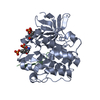
 Components
Components Homo sapiens (human) / Gene: INSR / Production host:
Homo sapiens (human) / Gene: INSR / Production host: 
 X-RAY DIFFRACTION / Number of used crystals: 1
X-RAY DIFFRACTION / Number of used crystals: 1  Sample preparation
Sample preparation SYNCHROTRON / Site:
SYNCHROTRON / Site:  NSLS
NSLS  / Beamline: X4A
/ Beamline: X4A Processing
Processing MOLECULAR REPLACEMENT / Resolution: 1.65→46.63 Å / Cor.coef. Fo:Fc: 0.956 / Cor.coef. Fo:Fc free: 0.953 / SU B: 1.98 / SU ML: 0.068 / Cross valid method: THROUGHOUT / σ(F): 2 / σ(I): 2 / ESU R: 0.101 / ESU R Free: 0.095 / Stereochemistry target values: MAXIMUM LIKELIHOOD / Details: HYDROGENS HAVE BEEN ADDED IN THE RIDING POSITIONS
MOLECULAR REPLACEMENT / Resolution: 1.65→46.63 Å / Cor.coef. Fo:Fc: 0.956 / Cor.coef. Fo:Fc free: 0.953 / SU B: 1.98 / SU ML: 0.068 / Cross valid method: THROUGHOUT / σ(F): 2 / σ(I): 2 / ESU R: 0.101 / ESU R Free: 0.095 / Stereochemistry target values: MAXIMUM LIKELIHOOD / Details: HYDROGENS HAVE BEEN ADDED IN THE RIDING POSITIONS Movie
Movie Controller
Controller




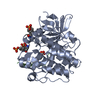
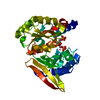
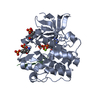
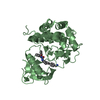


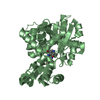

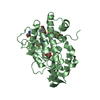
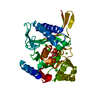
 PDBj
PDBj















